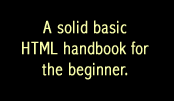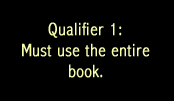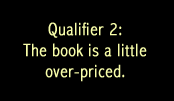Do I recommend this text? In short, yes, but with a couple reservations.
 It's definitely a good complement for those teachers who wish to incorporate HTML and Web design in a composition course without bogging it down with too much technical detail. It's easy to read and follow, stays away from "techie" definitions and explanations, offers a fair sample of short "Try It" activities one can incorporate into a classroom that has Internet connections, as well as gives longer Web page assignments that build as you progress through the book. Considering the pedagogical niche this text wishes to fill, this is a nice choice as a second text. Most of the weaknesses I've identified in the "Bad Stuff" section are marginal and can easily be overcome with a little planning and supplemental
material (of course, you have to know what that material is).
It's definitely a good complement for those teachers who wish to incorporate HTML and Web design in a composition course without bogging it down with too much technical detail. It's easy to read and follow, stays away from "techie" definitions and explanations, offers a fair sample of short "Try It" activities one can incorporate into a classroom that has Internet connections, as well as gives longer Web page assignments that build as you progress through the book. Considering the pedagogical niche this text wishes to fill, this is a nice choice as a second text. Most of the weaknesses I've identified in the "Bad Stuff" section are marginal and can easily be overcome with a little planning and supplemental
material (of course, you have to know what that material is).
From my own experience, books that cover material like this work best in classes that meet in computer labs. So if you plan on discussing much HTML and evaluating Web sites, you better have at least one computer with a high-speed Internet connection in the classroom for presentation purposes. It's best, of course, to be in a lab where everyone has a computer and an Internet connection to experiment with the text's material and ask questions as well as troubleshoot code.
The toughest job initially will be exactly how to incorporate the text's material into a preexisting course. As I've hinted in the "Bad Stuff" section, the book really should be used in the order the chapters are given, not in a pick-and-choose way (as its companion Web site and Preface
suggests). So I don't see this book useful for teachers looking to add a short, one-week "section" on Web pages in a
 composition or tech writing course – there's too much to read and go through in that amount of time, particularly for beginners.
composition or tech writing course – there's too much to read and go through in that amount of time, particularly for beginners.
The book is most useful if incorporated gradually, and entirely (read, of course, in order from chapter 1 to 9). And if one wishes to address all the important features of Web site design, a teacher must use at least the first 8 chapters – pretty much the entire book. While technically speaking you could create a nice Web site using chapters 1, 2, 4, 5, and parts of 3 and 7 only, you can see immediately that the book's chapters really work together to form a complete Web site. Most importantly, all the book's chapters help create a more complete discussion about Web sites, so choosing only a few chapters makes no sense if you wish to help students understand
most of the decisions a Web designer must consider at a design level. The book works best if a teacher incorporates, throughout the course of a semester or quarter, all the material in the order its presented. As you can see, this makes the text more than just a "secondary" text in a course. But it can be a less obvious under-girding base that the other material in the composition classroom bounces off of, illustrating the way considerations of audience and rhetorical strategies translate from one medium to another, one set of audiences to others.
In this sense, it can be a very effective comparative tool.
Price also becomes a factor. The suggested retail price is $31.00 USD. If you consider that the average brief  handbook/rhetoric is roughly $40.00, then, doing the math, the course using Batschelet's text costs each student a whopping $71.00, not including a reference handbook (like Hacker's
A Writer's Reference at $19.99, bumping up the course textbook cost near the $100 mark). Quite frankly, I don't think any student should spend this much on a composition course's text alone, nor, I'm sure, do they want to. Moreover, $31.00 for a text meant as a supplement seems a bit steep, particularly one that is not in color and brief (only 206 pages). This should be a $19.99
text (at best). Bedford/St. Martin's can do it for Hacker, why can't Allyn and Bacon/Longman for Batschelet?
handbook/rhetoric is roughly $40.00, then, doing the math, the course using Batschelet's text costs each student a whopping $71.00, not including a reference handbook (like Hacker's
A Writer's Reference at $19.99, bumping up the course textbook cost near the $100 mark). Quite frankly, I don't think any student should spend this much on a composition course's text alone, nor, I'm sure, do they want to. Moreover, $31.00 for a text meant as a supplement seems a bit steep, particularly one that is not in color and brief (only 206 pages). This should be a $19.99
text (at best). Bedford/St. Martin's can do it for Hacker, why can't Allyn and Bacon/Longman for Batschelet?
Finally, this text can be a wonderful addition to a 100-, 200-, or even
300-level writing course. Its straightforward and no-nonsense approach is
appealing, demystifying many aspects of Webpage creation. If you aren't
looking for a textbook but something that can help you create your own Web
pages, Web Writing/Web Designing is equally useful – even its
activities and Web exercises don't seem too "classroomy." It is not a
tutorial. A reader needs a bit more patience when using this book to create
a solid Web site. But if you're looking for a easy-to-follow rhetoric with a
strong "how-to" bent, this is the book for you.